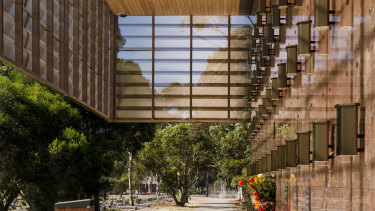Enduring materials make a memorable mausoleum
By Stephen Crafti
The Plaza of the Holy Angels is a beautifully conceived mausoleum using both the finest and enduring materials – granite, marble, bespoke bricks and a “veil” of stainless steel.
Architect Philip Harmer has become the go-to architect when it comes to designing mausoleums at Fawkner Memorial Park.

Each stone has a different colour, from blacks to gold veins through to those with green hues.Credit:Trevor Mein
Working with the Greater Metropolitan Cemeteries Trust and its CEO Deb Ganderton, together with the trust’s built environment team, this latest one is the fifth he has designed, with the previous, the circular Atrium (completed in 2017), nearby.
Unlike the Atrium, this new building is more a panhandle shape with the majority of the 1800 crypts located in a series of 3.5-metre-wide enfilades lined with 10 different types of marble, granite or quartzite.
Each stone has a different colour, from blacks to gold veins through to those with green hues.
“I selected the stones on the basis of their texture and also the way the sunlight reflects on the surfaces,” says Philip Harmer, director of Harmer Architecture.
Concrete also features strongly in the scheme, a material that’s well loved by the clients, predominantly the Italian community.
“I also wanted to bring in the landscape, with verdant vistas at either end of the galleries,” says Harmer, who worked closely with landscape architect Tim Hart from Urban Initiatives.
However, before one enters through one of the galleries, there’s a triangular-shaped forecourt in bands of bluestone for people to gather.
So, even from the forecourt, there’s a sense of transparency through the east-west galleries, with diffused natural light coming from the skylights or reflected from the bespoke leadlight panels, produced by glass artist Andrew Ferguson.
One of the starting points for Harmer Architecture’s design was to create 10 galleries in memory of well-known saints, including St Mary MacKillop and St Katharine Drexel.
Each saint is acknowledged on a plaque at the start of the gallery along with a grid marking out locations for loved ones, akin to wayfinding.
“I believe that it’s one of the largest mausoleums in Australia,” says Harmer, who was keen to create a nurturing environment, but one that would also last for hundreds of years (even the outdoor seating was constructed with in situ concrete).
“It’s a vast building and from the outset I wanted to create meaning and connection for this community,” says Harmer, who saw this project as also a way of combining architecture with art.
The copper statute in the forecourt was commissioned from artist Darien Pullen.
Even the bricks used for this project have a level of artistry, with Harmer’s team working closely with Kraus Brickworks in Stawell to produce bespoke irregular-shaped bricks that would add contrast with the highly reflective marble crypts.
“I didn’t want the exterior to compete with the galleries,” says Harmer, who appreciates the way the surrounding gum trees show their reflections as one walks through the galleries.
One of the most striking features about the new mausoleum is the stainless-steel eave that wraps around the entire building.
Approximately 4.5 metres in width, the lower portion is perforated while the higher panels are solid to reduce the effects from harsh sunlight.
The horizontal polished aluminium “veil” also established a counterpart to the former Atrium, creating a connection, but also its own character, in the process.
“It’s important to create protected areas, whether it’s from the glare of the sun, the rain or the wind,” says Harmer, who was also mindful of including built-in seats along certain pathways to allow people to sit and simply reflect.
As important was the garden and in particular the selection of plants. One can find, for example, a number of medical plants, with many also being soft in colour and to the touch (there are no spiky plants).
For Harmer, as with the other mausoleums, it’s important to create structure for perpetuity.
And rather than simply a series of passages one would normally encounter, here everything has been considered, including lights that contain vases to express the beauty of the stone and the fine Italian craftsmanship.